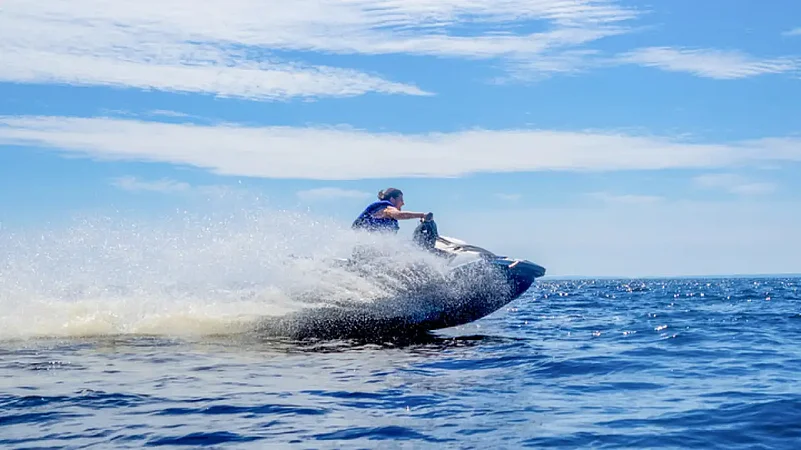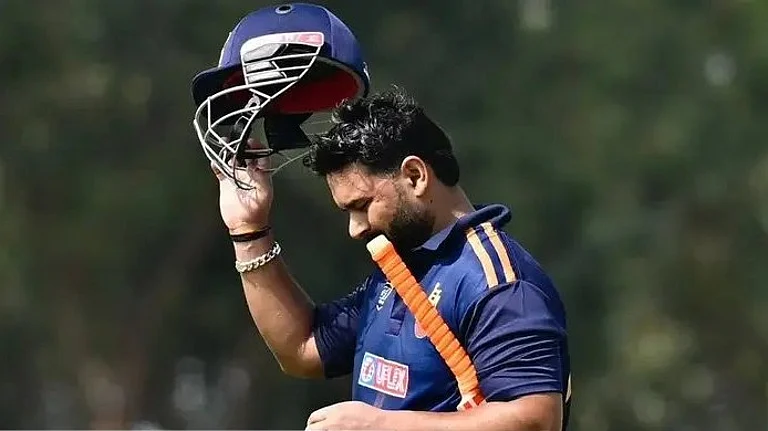While parasailing, there comes the moment when you are hoisted high up above the sea with a harness and a cable, at the greatest height possible. It is an absolutely serene moment, especially for first-timers—as you take a look around, all you can see is the inky blue water, some sea birds and the outlines of lands and shores in the horizon far away. At the same time, you can visibly feel all the tension washing away from your body and mind. It’s a brief period—a moment or two at best—but it’s one you wish would last forever.
These feelings are in direct contrast to the adrenaline-pumping but body-wrecking thrills of rides on vehicles such as bumper boats and jet skis. They depend much on the excitement generated by riding fast on the crests and troughs of the ocean waves—the reason why they are preferred during high tides, when the waters tend to be extra rough. But, while the jerky ride can make for a novel experience, be prepared to absorb the impact of each bump as they can be very hard indeed and can sorely test your core body strength. In a jet-ski ride, the impact of each bumpcan be felt more, but the arms of the rider/instructor that surround you from the sides add a layer of safety. On the other hand, the rubber bumper boat absorbs some of the impact of the rolling sea waves; however, you need to cling on to the handle with all your might, as there’s no other support to help you should things head south. Not surprisingly, neither of these activities is recommended to people suffering from back problems.
I experienced all this and more while participating in a number of water-sport activities (including the ones mentioned above and scuba diving) during a tour of the Konkan region in Maharashtra. Ganpatipule, a relatively unexplored, unspoilt beach in Ratnagiri district, proved to be the perfect setting for the jet ski and bumper boat rides against the evening twilight sun. Personally, the best bit about both rides was the salt spray that hit me as we rode the waves, completely rejuvenating me after what had been an excruciatingly long bus journey to get there. This was beset only by the resulting fatigue and body aches that persisted through what was a most restful sleep in the sprawling, luxurious property, managed by the Maharashtra Tourism Development Corporation (MTDC) right by the beach. The following morning, I participated in parasailing, where I enjoyed a level of bliss which I wouldn’t have believed was attainable—that too, while being suspended, mid-air. Contrary to what I had previously assumed, it was the furthest thing from scary.

However, the greatest source of nervous excitement and even panic, in this author’s humble opinion, probably comes during scuba diving. This may be especially true for non-swimmers such as yours truly who are trying out the sport for the first time. Of course, there are personal reasons for my judgement (I nearly drowned at the training pool!), but despite nearly every piece of the scuba diving equipment ensuring your safety, there are a number of manoeuvres, requiring precise mind-body coordination, that you need to efficiently master to prepare for eventualities such as water entering your goggles and/or respirator, which may make all the difference between a memorable dive and a disastrous one. For that very reason, my companions and I first headed to MTDC’s water sports training centre near Tarkarli beach in Malvan taluka in Maharashtra’s Sindhudurg district. Unfortunately, due to a rescheduling of our travel plans for the day, we could only begin our training post-afternoon, and had to get used to the rigours and demands of scuba diving in the open sea by watching a presentation and then making two attempts (three in my case, if you include the drowning episode) in the centre’s pool—once in the shallow end and the next in the deep end. That level of hurriedness is a surefire recipe for accidents—and as I would get to know later, one usually never heads to the open sea without five or six successful scuba diving attempts in the deep end of the pool (for a rough idea, the floor of the deep end of a pool lies at a depth of seven or nine feet, while, in the open sea, one dives 24 or 25 feet to reach the seafloor).
Be that as it may, after the completion of our training, a 50-minute ride on a private yacht brought us to the designated spot very close to a rocky outcrop on which the Vengurla Lighthouse is located. It was almost night (nearly 7 pm) by the time I dived into the water. Thankfully, a makeshift arrangement to shine light from the yacht into the waters below allowed me to spot brown corals and clusters of rapidly swimming, bright, shimmering blue, white and orange fishes, during the nearly 20 minutes I spent below water. Despite the unique nature of the dive and my happiness at completing it without any mishaps this time around, the overall non-existent visibility underwater left me disappointed. It was a poor reward, indeed, for fighting through and overcoming a near-death experience. Still, utmost thanks are due to Suraj S. Bhosale, my instructor and guide for the dive who runs the centre at Tarkarli. It was he who ensured my survival and saw to it that I stayed calm and composed during my attempts thereafter.
Perhaps, it happened too late for my sake, but conversations with the competent water-sports instructors at Ganpatipule and Tarkarli yielded useful insights into how you may enjoy and make the most of water sports in a safe manner. Here are a few of the highlights of the conversations and the tips elicited for water sports (in general) and scuba diving (in particular):
● Be absolutely frank to your guides regarding any health issues you may have faced or still are. They are the best persons to advise you on whether you should be attempting the sport at all or not. For instance, as mentioned above, back problems and pains inbones and joints make it risky, even impossible, for you to participate in jet-ski and bumper-boat or banana-boat rides. Similarly, breathing issues or ailments (including COVID-19) that wreak havoc on the body’s respiratory system and breathing apparatus may play spoilsport in case you want to participate in scuba diving.
● The greatest threat to any water sport is the erratic nature of ocean/sea currents, which can even be potentially fatal if one is not careful enough, says divemaster Anto of the water sports centre at Tarkarli. Before heading out, make sure to carefully consult the guides and instructors regarding the same. If you are still unsure, you may check the latest updates on the region’s weather and the prevailing sea conditions and forecasts on how these may change in the coming hours. Two other factors—tides and the season—are far less disruptive due to their more predictable natures. Water sports, at least in Konkan India, are best enjoyed in winter due to calmer seas and greater visibility. And while jet-ski and bumper-boat rides are usually organised during high tides, scuba dives happen mostly during low tides when the visibility is more.
● Water-sports organisers are not in favour of scuba diving at night time, due to the unpredictability of currents and the presence of fishing nets that prevent easy cruising on the seas. Mid-day is largely considered the best time for this activity.
● During the training session before your scuba dive in the open sea, pay close attention to and learn every aspect of the live demonstrations patiently provided by your instructor. Particular manoeuvres often turn out to be incredibly necessary. For instance, should water enter your goggles, you need to first take a deep breath through the mouthpiece of the rebreather, then tilt your head backwards—and with two fingers gently pressing your forehead, breathe out long and steady through your nose till the water in the goggles is emptied out. It is also important to keep equalising the air pressure inside and outside your ears—after every metre (or metre-and-half) of descent, remember to pinch your nose after taking a deep breath and then pop your ears. Long, deep breaths and slow exhalation are the key in the depths of the water, but if you keep hold (read: bite) the rebreather’s mouthpiece too firmly, you may end up with an ache in your jaw and end up letting go of it—a scenario akin to abandoning your life support. The instructors will tell you that it is important to hold the respirator in your mouth with just the right amount of pressure. Make sure to retain an 'O' shape in your mouth throughout your adventure—any attempt at smiling or moving your facial muscles is likely to result in water flooding into the mouthpiece of the rebreather. Make sure that the guiding team double-checks every piece of your scuba equipment, especially the level of gas in your diving cylinder and the potential presence of leaks and malfunctions in the equipment. Usually, a single scuba dive ends up using half of the volume of gas in the cylinder. Lastly, remember the gestures that are shown and taught to you. Each of them are vital in communicating your state to your guide during the dive, and are especially critical if you wish to convey that things are not okay. Remember—you cannot speak a single word during your scuba dive, neither can your words be heard if you are attempting to do so, should you be in a state of panic.
● I know this is easier said than done, but do not panic in case of any adverse situation. Instead of instinctively reacting (like I had done), keep your wits about you, and employ the contingency measures you have been taught. If you are still struggling, make sure to communicate to your guide using the correct gestures that things have taken a turn for the worse. Remember, experienced divemasters or guides are there for you every inch of the dive, and they keep continuously communicating with you to keep checks on your state and to remind you of the things you need to be doing at regular intervals. Under the sea, your life is as much their responsibility as your own.

























